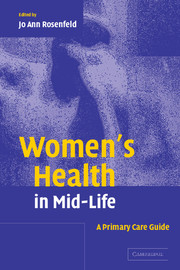Book contents
- Frontmatter
- Contents
- List of contributors
- 1 Introduction
- Part I Health promotion
- 2 Physical activity and exercise
- 3 Nutrition
- 4 Psychosocial health promotion of mid-life women
- 5 Sexual health
- 6 Alcoholism, nicotine dependence, and drug abuse
- 7 Depression and anxiety
- Part II Hormonal changes
- Part III Disease prevention
- Part IV Cancer prevention
- Index
- References
3 - Nutrition
from Part I - Health promotion
Published online by Cambridge University Press: 21 August 2009
- Frontmatter
- Contents
- List of contributors
- 1 Introduction
- Part I Health promotion
- 2 Physical activity and exercise
- 3 Nutrition
- 4 Psychosocial health promotion of mid-life women
- 5 Sexual health
- 6 Alcoholism, nicotine dependence, and drug abuse
- 7 Depression and anxiety
- Part II Hormonal changes
- Part III Disease prevention
- Part IV Cancer prevention
- Index
- References
Summary
Normal healthy diet
Case: S.K. is a generally healthy 49-year-old woman who presents for a routine annual exam. She complains of occasional hot flushes and asks what she can do about them without taking hormones. She also has a family history of cancer in several relatives, so she wants to know what she should do with her diet to stay healthy.
A healthy diet is a concern of people of all ages. Having traditionally been in charge of feeding the family, women tend to be even more interested. Current dietary recommendations for women in the mid-life years focus in three main areas: caloric balance, fat intake, and calcium.
Balancing intake and output
Perhaps the most important characteristic of a healthy diet is balance – a balance of food types and a balance of intake and output. To maintain a stable weight, one must burn off as much as one has taken in. Therefore, a healthy diet is always connected closely with healthy levels of activity (see Chapter 2 for details on exercise).
Two models that are useful regarding the proper balance of food types are the Food Pyramid and the New American Plate.
The Food Pyramid, developed by the US Department of Agriculture (USDA), illustrates the healthy diet as based on a foundation of plant-based foods, including whole-grain complex carbohydrates and substantial amounts of vegetables and fruits. Meat and dairy products make up a smaller proportion, with fats and sweets being used only sparingly.
Keywords
- Type
- Chapter
- Information
- Women's Health in Mid-LifeA Primary Care Guide, pp. 23 - 44Publisher: Cambridge University PressPrint publication year: 2004



